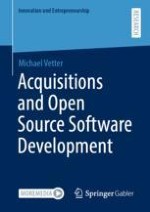2021 | OriginalPaper | Chapter
4. Quantitative Study: The Role of OSS for Likelihood and Timing of Acquisitions
Author : Michael Vetter
Published in: Acquisitions and Open Source Software Development
Publisher: Springer Fachmedien Wiesbaden
Activate our intelligent search to find suitable subject content or patents.
Select sections of text to find matching patents with Artificial Intelligence. powered by
Select sections of text to find additional relevant content using AI-assisted search. powered by
